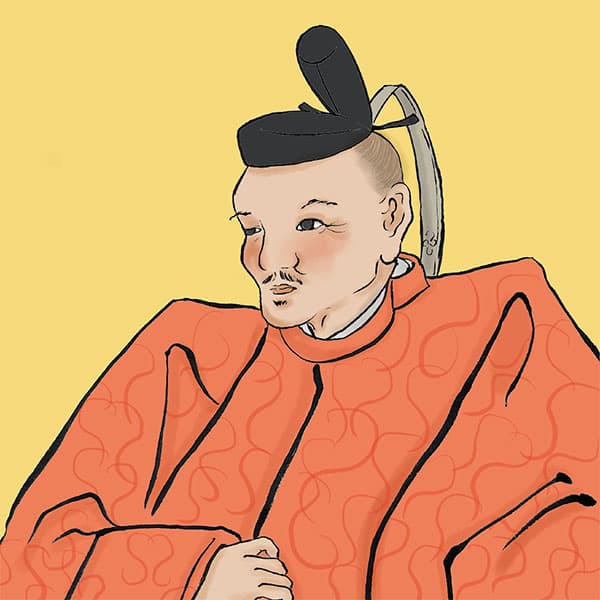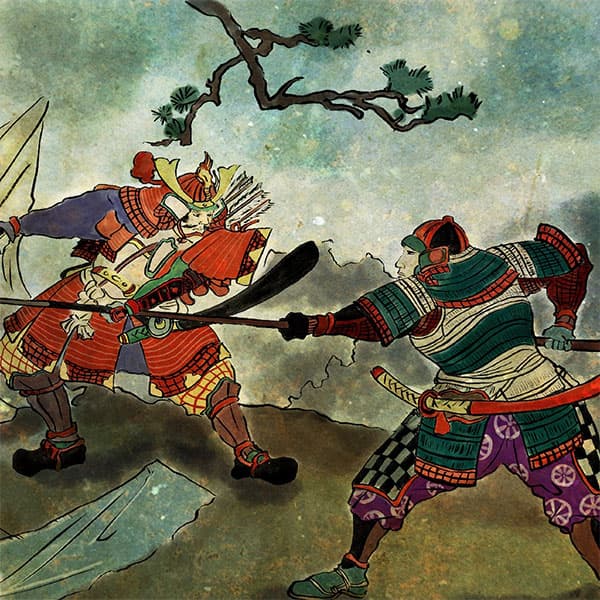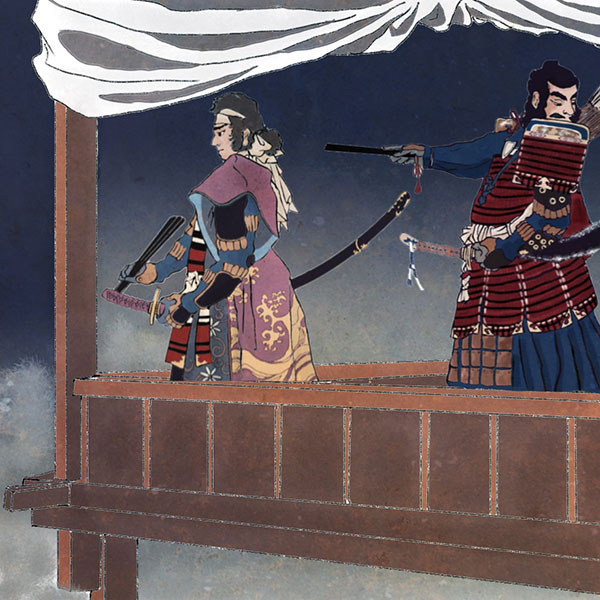Chikayoshi Hiraiwa (2/2)A loyal retainer who gained tremendous trust from the people of Japan.

Chikayoshi Hiraiwa
- Article category
- biography
- name
- Chikayoshi Hiraiwa (1542-1611)
- place of birth
- Aichi prefecture
- Related castles

Inuyama Castle
National treasure tower
Kofu Castle
- related incident
By the way, as was the case with Ieyasu's eldest son, Nobuyasu Matsudaira, Ieyasu had tremendous trust in Chikayoshi Hiraiwa, who faithfully served the Tokugawa family. Therefore, Ieyasu again entrusts Chikayoshi with the role of protecting Ieyasu's ninth son, Yoshinao.
In 1603, when Yoshinao Tokugawa, the ninth son of Ieyasu Tokugawa, was confined to the Kofu domain with 250,000 koku, Chikayoshi took over the administration of Kofu in place of Yoshinao, who was under Ieyasu in Sunpu as a child.
In 1607, when Tadayoshi Matsudaira, the fourth son of Tokugawa Ieyasu, who ruled Owari Province, died, Yoshinao Tokugawa succeeded him and moved to Kiyosu Castle. Chikayoshi also moved to Owari Province as Yoshinao's chief retainer, received 123,000 koku of Inuyama Castle, and began administering the domain of the Owari Tokugawa family.
Chikayoshi Hiraiwa ruled Owari Province while encouraging the young Yoshinao, but on December 30, 1611, he passed away in the Ninomaru Palace of Nagoya Castle. Passed away at the age of 70.
Chikayoshi Hiraiwa's grave is currently located in the Peace Park (Hiratain Cemetery) in Nagoya City, Aichi Prefecture. Myogenji Temple in Okazaki City, Aichi Prefecture also has the graves of Chikayoshi Hiraiwa, along with Tokugawa vassals such as Honda Tadatoyo, Tadataka, Ando Naotsugu, and Takagi Kiyohide.
The end of Hiraiwa Shinkichi and the Hiraiwa family
Chikayoshi Hiraiwa had no children. Therefore, Tokugawa Ieyasu regretted that the Hiraiwa family would become extinct, and gave Ieyasu's eighth son, Matsudaira Senchiyo (or Ieyasu's illegitimate son, also known as Matsachiyo), as his adopted heir, but Senchiyo died in 1600. As a result, Chikayoshi was ultimately unable to find anyone to succeed him.
After Chikayoshi's death, he made a will in which he bequeathed the territory of the Inuyama domain to Yoshinao Tokugawa, who served him. However, Ieyasu was still saddened by the extinction of Chikayoshi's family, and when he heard about the child rumored to have been born to Chikayoshi, he decided to have that child inherit the Inuyama clan.
This child served Masuyama Kawachi no Kami and called himself Masashige Hori Hayato, but the child's mother firmly denied that he was Shinkichi's child, so Chikayoshi's lineage, the Hiraiwa family, became extinct.
It is said that the Inuyama domain was ruled by his nephew Yoshinori Hiraiwa until 1617, when it was taken over by the Naruse family, an annex to the Owari Tokugawa family.
The Hiraiwa family of Chikayoshi's clan became retainers of the Owari domain and were called the Yugeshu. In addition, in the late Edo period, they continued to serve as feudal retainers of the Himeji domain, and it is said that this lineage continues in Hyogo prefecture and other areas even today.
Chikayoshi Hiraiwa and anecdotes
- Golden gift from Prince Hideyoshi
- This is a story about when Toyotomi Hideyoshi built Fushimi Castle.
To celebrate the construction of the castle, Tokugawa Ieyasu dispatched Ii Naomasa, Honda Tadakatsu, Sakakibara Yasumasa, and Hiraiwa Chikayoshi as envoys.
Hideyoshi gave 100 pieces of gold to the four visitors as a gift for the construction of the castle without telling Ieyasu.
Naomasa Ii and Tadakatsu Honda accept this obediently. After receiving it, Yasumasa Sakakibara reported to Ieyasu.
Chikayoshi Hiraiwa refused on the spot to Hideyoshi, telling Hideyoshi, ``I am receiving support from Tokugawa Ieyasu and have enough food and clothing, so I decline.'' It is said that Tokugawa Ieyasu had great trust in Chikayoshi's honest personality. - "Mikawa Go Fudoki" and Chikayoshi Hiraiwa
- One of the authors of ``Mikawa Go Fudoki'' is said to be Chiakichi Hiraiwa.
"Mikawa Go Fudoki" is a 45-volume book written about the process of the Tokugawa clan's establishment of the shogunate.It chronicles the 700-plus years from the Seiwa-Genji clan, the founder of the Tokugawa clan, to the inauguration of Tokugawa Shogun Ieyasu. I have
In the preface of this "Mikawa Go Fudoki", it is said that it was written by Chikayoshi Hiraiwa, written in May 1610 (1610), so it is thought to be written by Chikayoshi Hiraiwa, but in reality it was written after the Shoho era. It is unknown who actually created the book and who wrote the book. - Hiraiwa shawariishi
- Hiraiwa no Shiwariishi, located in Sakazaki, Kota-machi, Nukata-gun, Aichi Prefecture, is a huge stone (only one that remains today) was created when Ujishige Hiraiwa, an ancestor of Chikayoshi Hiraiwa, became the lord of Sakazaki following Tokugawa Ieyasu's ancestor Nobumitsu Matsudaira. It is said that he took the surname ``Hiraiwa'' after the stone (part of a huge rock).
Kofu Castle
Kofu Castle was a castle located in Kai Province (present-day Yamanashi Prefecture), located in present-day Ichijo Koyama, Kofu City, Yamanashi Prefecture. Also known as Maizuru Castle, it is designated as a national historic site.
Kai Province was ruled by the Takeda family from ancient times, centering on Tsutsujigasaki-kan (Takeda residence), but it fell into ruin under Katsuyori Takeda during the Sengoku period. After that, control passed to the Oda family and then the Tokugawa family.
It is said that in 1583, when the Tokugawa family assumed control, Tokugawa Ieyasu ordered Chikayoshi Hiraiwa to control Ichijo Koyama and planned to build Kofu Castle.
The Gohojo clan was destroyed in the Battle of Odawara in 1590, and Ieyasu was transferred to the Kanto region of the former Gohojo territory (Kanto transfer). Kai was given to Mitsuyasu Kato, a vassal of Toyotomi Hideyoshi, and later to Nagamasa Asano, and construction of Kofu Castle began in earnest during the Toyotomi daimyo period.
In the Edo period, the Kofu domain was established, and the area was managed under the direct control of the Edo shogunate.
In the Meiji period, Kofu Castle was abandoned and demolished due to the abolition of feudal domains and establishment of prefectures, and later, with the opening of the Chuo Main Line, the grounds where the castle was located were divided, and other than the stone walls, the castle was left almost untouched.
After the war, excavations were carried out to maintain the historic site, and restoration work began on the castle. Up to now, several kuruwa and gates have been maintained, and the Inari Yagura Tower was restored in 2003 (Heisei 15), and the Yamate Watari Yagura Gate on the north side, which had been separated, was restored in 2007 (Heisei 19).
Currently, the castle ruins have been maintained as ``Maizuru Castle Park'' and ``Kofu City Historical Park,'' and are currently open to the public.
Inuyama Castle
Inuyama Castle is located in the southern part of the Kiso River, on the border between Owari Province (present-day western Aichi Prefecture) and Mino Province (present-day Gifu Prefecture), and is located in present-day Inuyama City, Aichi Prefecture.
Inuyama Castle was built by the Iwakura Oda family during the Muromachi period, and was moved to its current location by Oda Nobunaga's uncle, Oda Nobuyasu, and became one of Oda Nobunaga's castles.
In 1607, when Chikayoshi Hiraiwa moved there as the chief retainer of the Owari Tokugawa family, it became the residence of the Hiraiwa family, and Chikayoshi Hiraiwa died in this castle.
When Chikayoshi passed away in 1617, his nephew Yoshinori Hiraiwa served as the castle's lord for six years, and thereafter the Naruse family, who were retainers of the Owari Tokugawa family throughout the Edo period, became the castle's lords.
In July 1871 (August 1871), with the abolition of feudal domains and establishment of prefectures, castles across the country were disposed of and destroyed, and Inuyama Castle was no exception. Most of the castle, except for the castle tower, will be relocated or demolished.
However, the castle tower was left behind and still stands today. Therefore, it is one of the 12 existing castle towers in Japan (12 existing castle towers), and is also one of the five castles designated as national treasures.
It is also said that because Masatoshi Naruse, the head of the Naruse family, was close to the head of the Dutch trading post, a carpet was laid on the top floor of the castle tower, and it was re-created during the Showa period repairs.
Inuyama Festival
In 1635, the Naruse family, which became the lords of the castle after the Hiraiwa family, issued a notice, and parishioners of Haritsuna Shrine began to put out decorative gurumayama and paper goods. Since then, there have been karakuri dolls on all 13 3-tiered Kurumayamas, and the votive karakuri dolls are displayed during the Inuyama Festival.
Held on the first Saturday in April, the festival is a gorgeous festival, with cars paraded under cherry blossoms during the day and illuminated by lanterns at night.
Reread Chikayoshi Hiraiwa's article
- related incident

- WriterTomoyo Hazuki(Writer)I have loved history and geography since my student days, and have enjoyed visiting historical sites, temples and shrines, and researching ancient documents. He is especially strong in medieval Japanese history and European history in world history, and has read a wide range of things, including primary sources and historical entertainment novels. There are so many favorite military commanders and castles that I can't name them, but I especially like Hisashi Matsunaga and Mitsuhide Akechi, and when it comes to castles, I like Hikone Castle and Fushimi Castle. Once you start talking about the lives of warlords and the history of castles, there's a side of you that can't stop talking about them.







